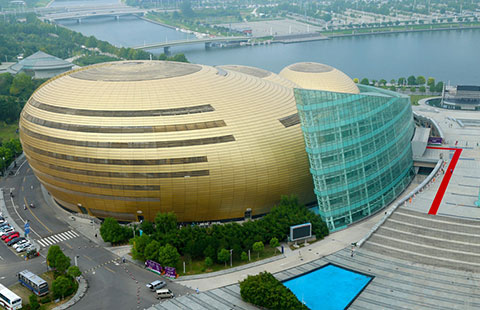

|
Closed meeting of China presidents of foreign multinational corporations. |
Editor's note: The following is the speech of the fifth Multinational Corporations Leaders' Roundtable by Zheng Wantong, vice-chairman of the 11th National Committee of the Chinese People's Political Consultative Conference, president of China International Council for the Promotion of Multinational Corporations and chairman of the Multinational Corporations Leaders Roundtable Organizing Committee.
Ladies and Gentlemen,
Good afternoon.
This year the Round Table Conference added a private session for presidents of multinational corporations, which provided a platform for us to better understand each other and find opportunities for cooperation.
Today, we from various multinational corporations, international business organizations, the UN and Chinese enterprises sit together and talk about grand prospects brought by the China's 12th Five-Year Plan (2011-2015). I believe that this day is of great significance and value.
Yesterday, Jia Qinglin, member of the Standing Committee of the Political Bureau of the Communist Party of China Central Committee and chairman of the National Committee of the Chinese People's Political Consultative Conference, spoke at the opening ceremony.
He analyzed the impact of multinational corporations on global economic development and human social improvement. He analyzed multinational corporations' contributions to the development of the world economy and to the advance of humanity.
He also explained how collaboration between multinational corporations and Chinese local enterprises is imperative for forward advancement in the current economic climate. His speech was a great inspiration for the private session and I would like to express my opinions on the development and innovation of multinational corporations in China.
First, multinational corporations are in a key period of modernization and opportunity. The international financial crisis has stepped into its fifth year and each country is actively seeking ways to get out of the crisis and resume growth - through ways from pumping liquidity into the market, to pushing forward "reindustrialization", to implementing an innovation strategy.
It becomes a common view and trend to almost every main economic entity that creative resources should be pushed to the high-end of the industry chain. We Chinese have an old saying: "Fortune and misfortune are neighbors," a phenomenon seen several times during the world economic crisis.
Severe economic crises in the past have shown that the powerful innovative impetus forced out by crises can bring about new technological revolutions, which in turn produce a batch of sustainable new industries with huge potential.
These enterprises can usually power major transformation in the economic development mode and economic structure, pushing the economy to regain balance before going to an even higher level. Now facing the eve of the world's sixth science and technology reform, we have seen the dawn of new capabilities and some key science and technology fields have presented breakthroughs.
These take form in material sciences, energy and resource sciences, information technology and life science. That is to say, whoever is the first to achieve breakthroughs will stand on top in this new economic and technology competition.
Of global enterprises, multinational corporations own 93 percent of the intellectual property and have 75 to 80 percent of the total technology research funds. They gather first-class technology talent that accounts for the core power to lead the world's science and technology innovation.
What's more, with years of global management experience, multinational corporations have a close relationship with the world market and have obtained accurate strategic observations. As is known to us, innovative multinational corporations, represented by Intel, Microsoft, Cisco, IBM and Apple, promoted the fifth science and technology reform - namely, information reform - all over the world. Therefore, science and technology innovation is not only an essential method for multinational corporations to cope with the crisis, but a necessary way to achieve self-development and strength.
Second, multinational corporations should spearhead the evolution of the global industrial system. After the global financial crisis, the world enters a new round of industrial restructuring and revolution. On one hand, developed countries intensified their support to traditional manufacturing and the real economy and actively pushed forward "reindustrialization".
In 2011, the United States launched the Advanced Manufacturing Partnership, while Britain decided to realize a rebalance from the financial to the manufacturing industry.
Emerging economies and developing countries, including Brazil and India also issued new manufacturing policies to speed up their pace in manufacturing. High-end manufacturing has become the new orientation for global industry restructuring.
On the other hand, major economies began to implement strategies on emerging industries, investing more in technology and science, industry and marketing to seize future developmental opportunities.
In general, the global economic structure has been in an adjustment phase, but science and technical innovation as well as industrial transformation are still in incubation stage with coexisting of surplus production capacity in traditional industries and uncertainties in the development of new industries.
The new dominating industry and international division of labor haven't yet formed. During void in the global industrial system, multinational corporations, the important dominant force of economic globalization, should shoulder major responsibility and play a leading role in the restructuring and evolution of global industrial system.
China has formed a large-scale and comprehensive industrial system after more than 30 years of rapid development, which plays an important role in global industrial division.
Yet China is confronted with a hard situation in realizing fundamental shifts in economic development due to its unreasonable industrial structure and overall low-level industry.
Over the long term, powerful technical support and management innovation are needed to upgrade China's traditional manufacturing industry; the expansion of new strategic industries, like new energy, new materials, energy-saving and environment-protection as well as biological medicine; and the accelerated development of modern service industries such as finance and logistics, trade and exhibitions, technical and business services.
This provides multinational corporations more market opportunities for deep cooperation with China. It is estimated that by 2015, sales revenue of China's high-end equipment manufacturing industry will exceed $6 trillion; the output value of environmental protection industry will reach $2 trillion; the total export-import volume in China's service industries will surpass $1.25 trillion in the next five years.
I sincerely hope that multinational corporations can attach great importance to and intensifying mutual beneficial cooperation with China in the global industrial revolution and adjustment, as well as play a more significant role in China's industrial restructuring and the evolution of global industrial system.
Third, multinational corporations should expand space for development to meet China's push for coordinated urban and rural development. China is a vast country with a large population and imbalanced development between rural and urban areas. Since the go-west strategy was put forward, the government has actively guided funds and human resources to western, central China and rural areas to promote a coordinated development.
I, at the CPPCC, have led several teams of experts for on-site investigations at the Guangxi Beibu Gulf opening and development, the integration of economy and society in Chengdu and Chongqing, the Wuhan city circle, the Changsha-Zhuzhou-Xiangtan city group constructions, Yunnan's opening to Southeast Asian countries, and the Dabie Mountains old revolutionary base development. The policy suggestions we put forward got the attention of the Party and the government, with some even becoming national strategies.
According to these surveys, I am convinced that the leaders and people in these areas have strong development desires and these areas are equipped with a good political landscape, investment environment and markets. Thanks to improving transport infrastructure, low labor costs, abundant energy resources and strong policy support, western and central China have the huge potential for growth and can lead China's sustainable and sound development.
The government of China proposed that by 2020 western China would be an important energy base, deep resource processing base, equipment manufacturing industry base, and strategic new industry base with sound infrastructure and complete modern industrial system.
As a result the government carried out the "Industry Guidance Directory of Foreign Investment" to encourage foreign investment in competitive industries and infrastructure construction in western China, and stimulate the service trade in western China to open wider to the outside world.
China is developing a unique path of urbanization suited to its realities, which provides great opportunities for multinational corporations. During the 12th Five-Year Plan period (2011-2015), around 9 million people from rural China will have moved into urban areas.
For China to enter the stable stage of urbanization, 200 million to 300 million people from rural areas are expected to move into urban areas. The process will increase domestic demand substantially and become the engine of economic growth. China is supporting the development pattern for development of big and medium cities as well as small towns. Spreading and numerous second- and third-tier cities will receive migrant workers so that the demands of investment, consumption and industries will be remarkably considerable. These cities will be the potential markets for the multinational corporations.
You will see clearly that China is embarking on a road of better coordination between rural and urban areas, better balance among different regions, and more comprehensiveness. If multinational corporations are able to combine their own global strategic layout, industry development and technology research and development with China's coordinated regional development and urbanization, they will win more opportunities and gain more returns.
The present world is an open one, and today's China is also open. After years of mutually beneficial cooperation, multinational corporations and China have become intertwined, both dedicated to promoting scientific and technical innovation for a higher-level development. In the context of a gloomy global economy and global industrial restructuring, deep cooperation between multinational corporations and China is helpful for the two parties to take advantage of each other's strengths and achieve a win-win situation.
Let's work together to implement scientific and technological innovation, deepen mutual beneficial cooperation and make contributions to the expansion of transnational corporations, fast and steady development of the Chinese economy, as well as a sustained world economic recovery.
Finally, I wish the private session success.
Thank you.
(China Daily 06/27/2012 page6)












